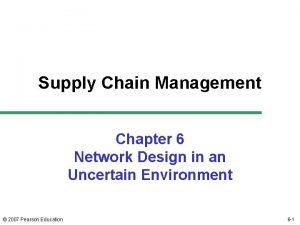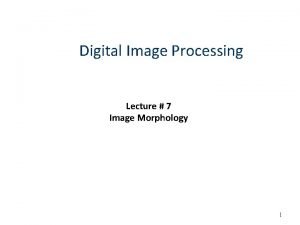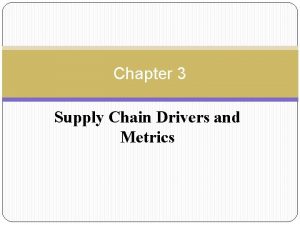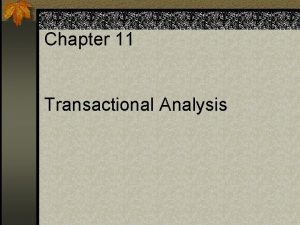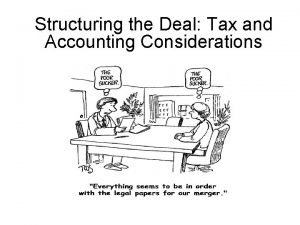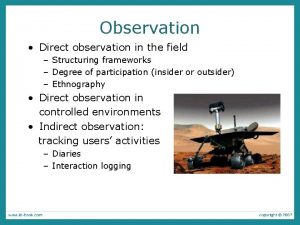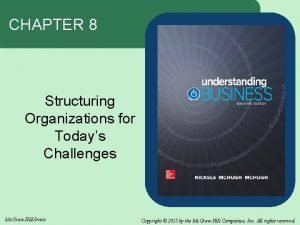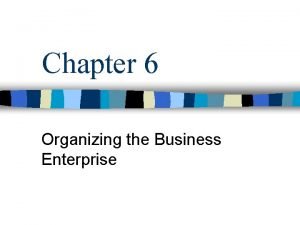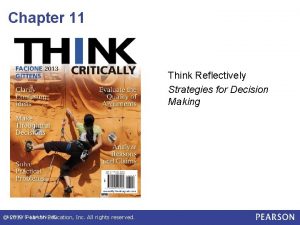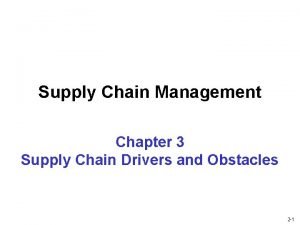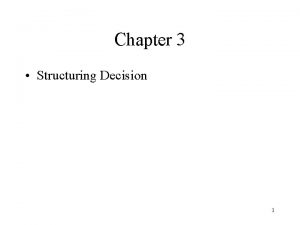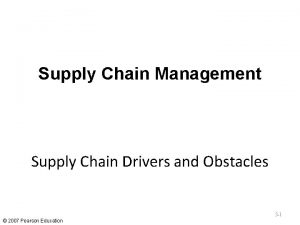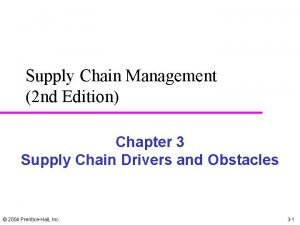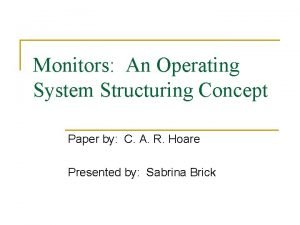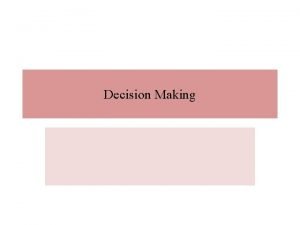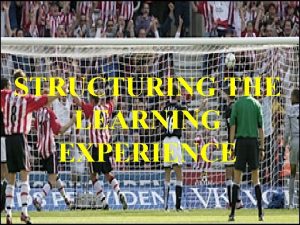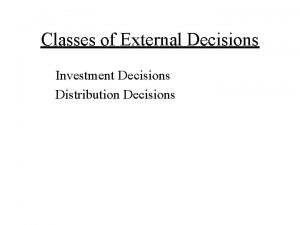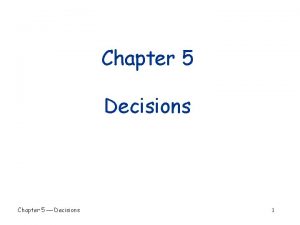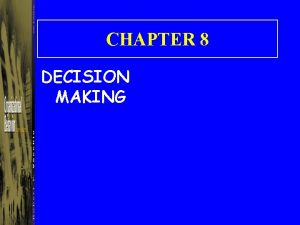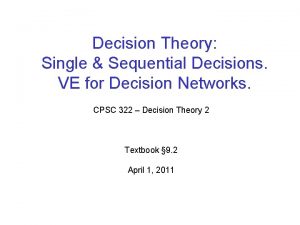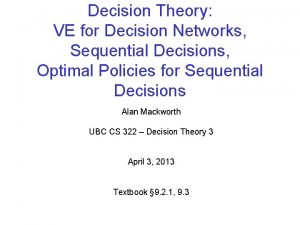Chapter 3 Structuring Decision 1 Structuring Decisions Learning

































- Slides: 33

Chapter 3 • Structuring Decision 1

Structuring Decisions Learning Objectives • Fundamental steps in model creation • Identify and structure values and objectives – Fundamental objectives and hierarchies – Means objectives and networks • Graphical methods for decision frameworks – Influence diagrams – Decision trees • Concepts for model details – Elements – Probabilities – Cash flows – Objectives measurements 2

Structuring Decisions Three fundamental steps to create a decision model: 1. Identify and structure the values and objectives 2. Structure the decision elements into a logical framework 3. Refine and precisely define all elements of the model 3

Identifying and Structuring Values and Objectives • Identify important issues consistent with values • Identify and define relevant objectives • Organize objectives – Fundamental objectives and hierarchies – Means objectives and networks • Ensure consistency with context 4

Fundamental Objectives • General and reflect values • Organized in hierarchies • Paste figure 3. 1 5

Means Objectives • Identify how to accomplish fundamental objectives • Organized in networks • Paste figure 3. 2 6

Decision Context Three criteria for consistency of values-based objectives and decision context: 1. Properly reflective of decision situation 2. Decision owner has authority to make decision 3. Feasible to conduct analysis within resources 7

Structure Elements into Framework Two graphical methods: • Influence diagrams • Decision trees 8

Influence Diagrams • Geometric representation of decision elements: – Rectangles: represent decisions – Ovals: represent chance events – Diamonds: represent payoffs – Round-cornered rectangles: represent intermediate consequences or mathematical calculations 9

Influence Diagrams • Geometric shapes are called nodes – Rectangles: decision nodes – Ovals: chance nodes – Diamonds: payoff nodes – Round-cornered rectangles: consequence or calculation nodes 10

Influence Diagrams • Nodes connected by arcs to represent relationships • Nodes are named – Predecessor: if at beginning of arc – Successor: if at termination of arc Copy figure 3. 7 11

Influence Diagrams • Arcs represent two types of relationships, defined by the successor node • Arcs can represent sequence or relevance – Sequence: successor node is decision node – Relevance: successor node is any non-decision node Paste figure 3. 8 12

Influence Diagrams • Basic influence diagrams – Basic risky decision: One decision and one uncertainty – Imperfect information: Imperfect information about an uncertainty influences payoff – Sequential decision: Result from one decision determines if another decision is to be made – Intermediate calculation: Compiles predecessors information 13

Influence Diagrams Basic Risky Decision • Copy the figure 3. 9 Is the potential gain from choice A worth the risk that must be taken? 14

Influence Diagrams Imperfect Information • Copy the figure 3. 10 Imperfect information about uncertain event received and decision made; uncertain event is then resolved. Both decision and event affect payoff 15

Influence Diagrams Sequential Decisions • Copy the figure 3. 12 Sequential decisions reveal time sequence 16

Influence Diagrams Intermediate Calculations • Copy the figure 3. 16 Calculation nodes emphasize diagram structure 17

Creating Influence Diagrams • • No single strategy for creation Identify decision context and objectives Create simple version, then add details Unique representation rare 18

Creating Influence Diagrams Three common mistakes • Confusion with flow charts • Misuse of sequence arcs • Inclusion of cycles 19

Decision Trees • More details; sequential and chronological flows • Representation of events: – Square: decisions to be made – Circles: chance events • Branches from squares represent alternatives available • Branches from circles represent the possible outcomes of chance events • Final consequences or payoffs at branch ends • Decision trees flow from left to right 20

Decision Trees • Copy the figure 3. 21 – Alternatives: mutually exclusive; collectively exhaustive; select only one – Outcomes: mutually exclusive; collectively exhaustive; only one can occur – Complete tree includes all possible decision paths, alternatives and outcomes 21

Decision Trees • Multiple objectives: – List payoffs at branch ends – Can be cumbersome and bulky • Basic decision tree forms: – – – Basic risky decision Double- risk dilemma Range-of-risk dilemma Imperfect information Sequential decisions 22

Decision Trees Basic Risky Decision • Copy figure 3. 24 23

Decision Trees Double-Risk Dilemma • Copy figure 3. 26 24

Decision Trees Range-of-Risk Dilemma • Copy figure 3. 27 25

Decision Trees Imperfect Information • Copy figure 3. 28 26

Decision Trees Sequential Decisions • Copy figure 3. 29 Alternatives at second decision do not change as a result of outcome A or B 27

Decision Trees vs. Influence Diagrams • Decision trees – Display more information – Can become cumbersome • Influence Diagrams – Graphical presentation relatively simple – Easier for some to understand 28

Decision Trees vs. Influence Diagrams • Decision trees and influence diagrams are complementary • Strategy for use: – Start with influence diagram to understand major elements – Convert to decision tree to document details 29

Decision Details Defining elements • Elements must be measurable • Element definitions must require no judgment or interpretation 30

Decision Details Probabilities and Cash flows • Chance events require probability assignments – Only one outcome can occur – Probability of an outcome must be between 0 and 1 – Probabilities at chance node must sum to 1. 00 • Cash flows specified on branches – Cash flows compiled at branch ends to show consequences – Net present values used to reflect timing effects 31

Decision Details Measuring fundamental objectives • Measurement is crucial • Measure lowest level objectives in hierarchy • Measurement scales identified by attributes – Natural attribute scales – Proxy (surrogate) attribute scales – Constructed attribute scales 32

Summary • • Fundamental steps of model structuring Identify and structure values and objectives Graphical methods for structuring models Concepts for model details 33
 Poster making meaning
Poster making meaning No decision snap decision responsible decision
No decision snap decision responsible decision Financial management process
Financial management process Screening decisions and preference decisions
Screening decisions and preference decisions Network design decisions using decision trees
Network design decisions using decision trees Part 6 you make the decision - distribution decisions
Part 6 you make the decision - distribution decisions Four sales channels
Four sales channels Cuadro comparativo entre e-learning b-learning y m-learning
Cuadro comparativo entre e-learning b-learning y m-learning Decision table and decision tree examples
Decision table and decision tree examples Structuring system requirements
Structuring system requirements Structuring arguments
Structuring arguments Image erosion
Image erosion Image
Image Time structuring in transactional analysis
Time structuring in transactional analysis Drivers of supply chain management
Drivers of supply chain management Types of transactions in transactional analysis
Types of transactions in transactional analysis Transactional analysis
Transactional analysis Reverse triangular merger
Reverse triangular merger Direct observation
Direct observation Global tax structuring
Global tax structuring Structuring organizations for today's challenges
Structuring organizations for today's challenges Organizational structuring
Organizational structuring Mixed departmentalization
Mixed departmentalization Dominance structuring examples
Dominance structuring examples Framework for structuring drivers
Framework for structuring drivers Islamic structuring
Islamic structuring What are the 5 stages of the counseling process?
What are the 5 stages of the counseling process? Structuring element dapat berukuran
Structuring element dapat berukuran Structuring element dapat berukuran
Structuring element dapat berukuran Morfologi citra adalah
Morfologi citra adalah Structuring
Structuring Framework for structuring drivers
Framework for structuring drivers Framework for structuring drivers
Framework for structuring drivers Monitors in os
Monitors in os




